João V. Tomotani
Universidade de São Paulo; São Paulo, Brazil.
Email: t.jvitor (at) gmail (dot) com
https://doi.org/10.5281/zenodo.8241665
Light novels are a subculture of Japanese literature primarily targeting the young adult demographic, with the average length of 50,000 words, a dense publishing schedule, and usually illustrated with an anime/manga art style (Wikipedia, 2020). Due to their demographic, light novels are generally written in a simpler, more approachable fashion, and there is often an overlap between them and novels classified as young adult, middle grade, and children’s literature. This is most evident when you find translated foreign novels, redesigned into a light novel style (English Light Novels, 2020).
Still, a more clear-cut definition of light novels has not yet been achieved, as they contain a lot of different features. Japanese literary critic Enomoto Aki, for instance, defined light novels as “entertaining literary work for readers in junior high school or high school”, while the publishing house Nikkei Business Publications defines them as “books using anime pictures as covers and aimed at young readers” (Teipei Teen Tribune, 2020).
The term ‘light novel’ originated from “user participation” and was coined around 1990 by Kamikita Keita, the system operator of the Science Fiction and Fantasy forum in the Nifty Serve BBS (Saito, 2014). The light novel trend in juvenile novel markets was testified by the science fiction writer Ōhara Mariko in a book review for a newspaper in 1994 (Saito, 2016). Ōhara was impressed and confused with the increasing popularity of a group of novels referred to as ‘light novels’, one of the earliest examples of the use of this term (then still a neologism mostly restricted to online communities).
Ōhara’s negative tone when using the term indicated her ambivalent position towards it, criticizing the proximity to manga for prioritizing characters over story, unrealistic settings, and shallow content (Fig. 1). She concluded that those works could not be categorized as novels (shōsetsu) and should be only consumed as a passing entertainment that did not produce lasting emotional impact on the readers (Saito, 2016).
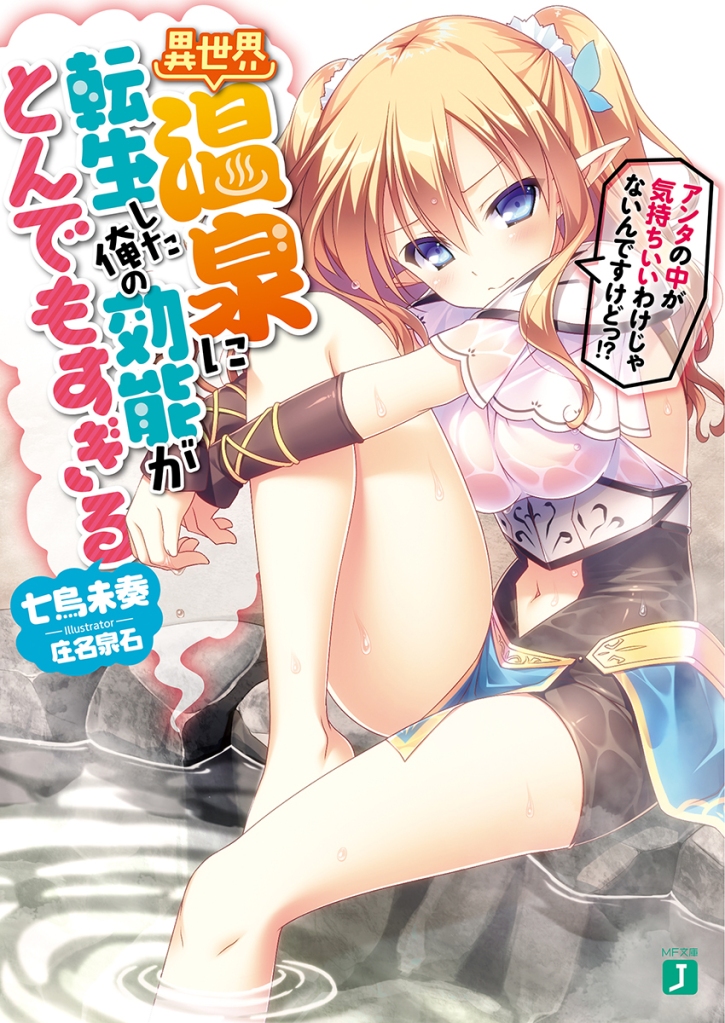
Light novels are an evolution of pulp magazines in Japan. In the 1970s, many pulp magazines began to put illustrations in their stories and included anime, movies and video game articles to cater to their audience. Arai Motoko, a science fiction and fantasy writer active mainly in the young adult market, is considered one of the harbingers of the breathless, chatty style of literature, typical of light novels (SFE, 2020). She is also credited with the popularization of the term ‘otaku’ in Japanese popular culture by using it in her works. Other famous work from this period is the heroic fantasy novel Guin Saga, by Kurimoto Kaoru, in continuous publication since 1979 (though the original author died in 2009, at which time this novel was the longest single-writer’s work in the world).
Other very famous light novels (also in the West) are: Record of Lodoss War and Slayers, published in the 1980s, which contributed to the development of the fantasy and high fantasy genres in Japan; Boogiepop and Full Metal Panic, published in the 1990s, that mixed the action, fantasy and military themes with everyday student lives; the phenomenon Haruhi Suzumiya, published in 2003 and possibly a major turning point in the light novel and anime industry, by playing with the anime and manga tropes of the time, reflecting otaku culture, and being wildly popular on the Internet; and Sword Art Online, initially published as a web novel in 2002, that vastly contributed to the popularization of the ‘isekai’ genre (literally “different world”, a genre that revolves around a normal person from Earth being transported to or reborn in another fantastical universe) – a commercially successful genre today, as seen in novels like KonoSuba, Overlord and Re:Zero (Fig. 2).

As argued by Saito (2015), with the participatory culture of the Internet, story writing became the major source of small narratives for its ease in creating consumable media content. While the Haruhi Suzumiya franchise mimics this participatory culture of the digital age, Sword Art Online was born out of the actual user participation in the creation and dissemination of the media content. The success of Sword Art Online has contributed to the creation of many write-your-own-fiction websites in Japan over the past years.
A similar phenomenon was identified by Hansen (2016) with the ‘cell phone novels’ (or ‘keitai novels’), that became a significant commercial success in Japan. Keitai novels also generated considerable literary criticism, but that had little impact on their continued success, which is presenting challenges not only to traditional critical interpretation of fiction, but also to the very manner that literature is created, disseminated and received. For an interesting analysis on the Japanese pop culture trends of fiction since the 2000s, with the popularization of themes like sekaikei (“end-of-the-world crisis”), sabaibukei (“survival”), and nichijōkei (“slice of daily life”), refer to Tanaka (2014).
GOD’S BLESSING ON THESE WONDERFUL LIGHT NOVELS
A very peculiar feature of light novels is their titles. The titles are (in)famous for being unusually long, often composed of large sentences that give a summary of the plot, interjections, and filled with excessive punctuation marks such as exclamation and interrogation marks (Fig. 3). An article from the satirical anime news website Anime Maru, even joked about the possibility of the release of a light novel composed solely of a 196-page-long title (Anime Maru, 2016).

Two analyses of the increase in the size of light novel titles have been done in the past. The first one was conducted by Twitter user @GenreCodeLovers, who compiled a list of light novel titles from the website Ranobe Mori and analyzed the number of Japanese characters (apparently not corrected for polysyllabic kanji) in them (reported by Parker-Dalton, 2019). The second one was made by YouTuber Red Bard (2019), who compiled a list of English titles from the website MyAnimeList and counted the number of words, in order to identify the moment in which titles became so long. She concluded that the movement started between 2009 and 2013, but really caught on in 2014.
The objective of the present work is to expand on those studies, following a more structured and scientific protocol and analyzing results via statistical tests. Using the original Japanese titles, we will evaluate the progression in title size by counting the number of characters. In addition, we will try to identify whether the larger title sizes are related to the novels’ literary genre. Finally, we will identify which are the most common themes and words among the titles.
LIST ART ONLINE – BUILDING A LIST OF LIGHT NOVELS
Our light novel list was composed from two complementary online sources: the website English Light Novels (https://englishlightnovels.com/list-of-light-novels-alphabetical/) and Wikipedia (https://en.wikipedia.org/wiki/List_of_light_novels). While the titles acquired from the former website were restricted to novels officially published in English, Wikipedia listed all titles (regardless of publication in English) that have their own Wikipedia page (mostly due to having a sufficiently successful anime or manga adaptation).
For each title, we extracted the following information:
- Original title of the light novel, in the Hepburn Romanized form. For almost all cases, the Romanized form was provided by the website itself. In case this information was not available, we searched for a Romanization in either Baka Updates (https://www.mangaupdates.com/) or MyAnimeList (https://myanimelist.net/). Whenever the titles contained words originally in English, they were left unchanged (katakana forms of foreign words, however, were Romanized as usual). Punctuation was also left unchanged.
- Translated title of the light novel to English. Whenever the light novel was formally released in English, the official title was used. Otherwise, a literal translation was used.
- Year of publication (in Japan) of the light novel’s first volume (or the year the first chapter was published online, in the case of web novels).
- Genre(s) of the light novel. For most novels, the list of genres was provided by the two websites mentioned above; otherwise, they were obtained from MyAnimeList.
The list was compiled on August 9th, 2020, and had a total of 498 different titles.
From those, we distinguished titles that were not originally light novels. For instance, light novels based on a manga (e.g., Attack on Titan and Death Note), anime (e.g., Eureka Seven, Anohana, Sarazanmai), OVA or movie (e.g., FLCL, The Boy and the Beast, and those by Makoto Shinkai), video game or visual novel (e.g., Kingdom Hearts, Danganronpa, Higurashi, and the Fate/Stay Night franchise). Also, we distinguished the original novels from sequels, side stories or spin-offs, such as The Reprise of the Spear Hero (from the Shield Hero series), Is It Wrong to Try to Pick Up Girls in a Dungeon? On the Side: Sword Oratoria (side story of the Danmachi light novel), Wolf and Parchment: New Theory Spice and Wolf (sequel of Spice and Wolf light novel). After this, we concluded that 406 out of the 498 listed titles were original light novels, while the remaining 92 were not.
Re:SULTS – STARTING AN ANALYSIS IN THIS ARTICLE
For our analyses, we used only those 406 light novels that were original titles. Since many of the novels that were sequels or spin-offs included the title of the original novel in their own titles (e.g., Is It Wrong to Try to Pick Up Girls in a Dungeon? On the Side: Sword Oratoria) and thus, were naturally longer, they would have biased the analyses.
Firstly, we evaluated how the average number of characters in the title changed from year to year. For this analysis, we used the original Japanese title in romanized form, also including any punctuation and spaces, and considered the year of the novels’ first publication in Japan. The results can be seen in Figure 4.
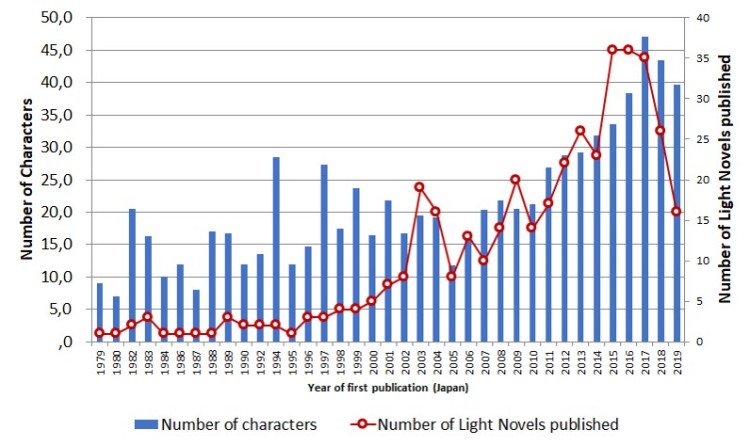
From this first analysis, we can clearly see an increase in the number of novels published and a clear increase in the average number of characters since the late 1970s. The years of 2018, in particular, had a whooping average of over 45 characters per title. The longest title award, though, goes to the R18 novel published in 2016 Yami Zokusei no Mahoutsukai daga, naze ka Yuusha ni Natte Shimatta ~Sore wa Tomokaku Yome ni Ii Kurashi wo Saseru Tame ni Ganbatte Nariagarou to Omou, or “Busy Wizard: This Warlock Just Wants to Provide for his Wives!” (Fig. 5).
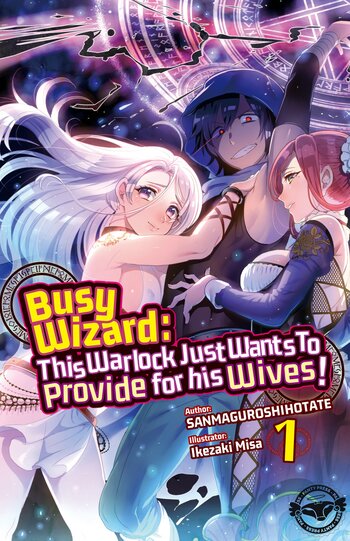
In order to identify the precise year when the increase in title length started, we used a continuous piecewise linear model, popularly referred to as broken-stick model. In regression models, it is often assumed that the regression function has the same parametric form throughout the domain of interest. However, it might be possible that a regression function is composed of a sequence of submodels, that is, multiple linear segments (Das et al., 2016). The segments can form a continuous function, but with discontinuities in slope at “transition points” between each segment.
It is relatively easy to fit the segmented curves when it is known in advance where each transition point is. When the transition points are unknown, as in our case, the problem becomes more difficult and we need to use the data to estimate where the transition points are. Hudson (1966) developed an algorithm to obtain the best fit iteratively. With a large number of transition points, this iterative procedure can be very complex, but as we are assuming the existence of a single point (that is, a specific year when the trend started), it is much simpler to proceed testing every point for the best fit for the method of least squares.
After applying this procedure in our data, we see two possible transition points with the same fit: 2004 and 2010 (Fig. 6). Looking at the results, with the error bars for each year, we can see that until 2010, the average number of characters per title changed very little – one could say that it almost remained unchanged, considering the error bars – but that an increase is very noticeable after 2010. The transition point in 2004 being a good fit, though, is most likely due to 2005 being an outlier with some very short titles (including the shortest one in our list, the yaoi novel Esu or S, Fig. 7). Thus, it is more likely that the transition point is truly 2010. This result is aligned with the one estimated by YouTuber Red Bard (2019), who eyeballed the start of this trend between 2009 and 2013.


NO GENRE, NO LIFE
To analyze how the genre of the light novels affected the expected number of characters of the title, firstly we identified the 10 most “popular” genres, that is, the ones with the largest number of novels. The ten most popular genres were: fantasy; comedy; romance/romcom; action; adventure; isekai/virtual reality; drama; science fiction; harem; and mystery. One could argue that some of these are not really literary genres, such as isekai or harem (and one would most likely be right according to most literary experts), but given the source material at hand, we obviously had to consider them.
Once the “most popular” genres were defined, we calculated the average number of characters per title for each genre. The results are shown in Table 1.
From the results in Table 1, we can see that the wordiest titles are by far in the isekai genre, followed by fantasy. This was not really a surprise, considering how many of the longest titles were classified as isekai or fantasy, as seen in the longest titles (Table 2).
Due to the expected intersection between the fantasy and isekai genres, we excluded isekai novels from our analysis, expecting a sharp decrease in the title length of fantasy novels (Table 3). However, the fantasy genre remains the one with the longest titles, dropping from an average of 33.1 characters in the title to 31.2. The comedy and adventure genres, though, were the ones most affected by the removal of isekai novels (respectively, decreasing from 31.4 to 26.8, and 27.7 to 23.7 characters), hinting that a larger number of characters in isekai novels’ titles might be related to a more comedic tone (Table 3).
IS IT WRONG TRYING TO PICK UP CONCLUSIONS IN THIS ARTICLE?
To identify some common themes in light novel titles, we used an online word cloud generator (Davies, 2018) to highlight the most common words used in the titles, in both English and Japanese (Fig. 8).

By looking at the word clouds, the presence of the fantasy and isekai themes is evident in both languages. It is easy to identify words related to (1) a magical setting, such as: magic (mahou in Japanese), magical (majutsu, more literally ‘magical arts’), witch (majo); (2) words related to dungeons & to dragons: dungeon (danjon), monster (monsuta), demon (maou), alongside elf and vampire in English translations of the titles, and megami (goddess) in the original Japanese titles; (3) words related to medieval settings, such as: princess (hime), hero (yuusha), alongside king and knight in English translations of the titles; and, finally, (4) words directly related to the isekai concept, such as: another and world (typically used in tandem), reborn, reincarnated in English and sekai (world), isekai (another world), tensei (reincarnation) in Japanese. It is important to note that the titles of isekai novels sometimes have those specific words as a self-referential joke or parody, thus skewing this word cloud.
Other very common themes are school settings. This includes the words school (gakuen) and words related to girls/women in general (considering that the majority of the audience is expected to be male teenagers and young adults). The latter includes the words girl and sister in English titles, but is more varied in Japanese: musume (daughter), otome (maiden), imouto (younger sister), kanojo (girlfriend), and shoujo (girl).
From our analyses, we can conclude that the increase in the length of light novel titles is a true phenomenon that can be observed statistically. Light novels, as argued by Saito (2016), successfully bridged the increasing gulf between the expanding visual media and the conventional print media, having a very strong market in Japan, which is very competitive, where successful novels can have manga and anime adaptations, while successful anime and manga can have light novel prequels, sequels and spin-offs. It is possible that in order to survive in that market, publishers opt to invest in increasingly larger titles, in order to draw the reader’s attention and immediately inform them about the genre and content of the light novel through the book’s spine alone (Fig. 9), while also investing in colorful and appealing covers.
Thus, the increase in title sizes is a somewhat recent phenomenon. So, for now, let’s observe how this trend develops, while hoping for a new Konosuba anime season.

WOLF AND REFERENCES: OLDER THEORY SPICE AND WOLF
Anime Maru. (2016) New light novel consists entirely of one long title. Available from: https://www.animemaru.com/new-light-novel-consists-entirely-of-one-long-title/ (Date of access: 9/Aug/2020).
Das, R.; Banerjee, M.; Nan, B.; Zheng, H. (2016) Fast estimation of regression parameters in a broken-stick model for longitudinal data. Journal of the American Statistical Association 111(515): 1132–1143.
Davies, J. (2018) World Cloud Generator. Available from: https://www.jasondavies.com/wordcloud/ (Date of access: 9/Aug/2020).
English Light Novels. (2020) An introduction to light novels. Available from: https://englishlightnovels.com/an-introduction-to-light-novels/ (Date of access: 9/Aug/2020).
Hansen, K. (2016) Eletronic literature and youth culture: the rise of the Japanese cell phone novel. In: Hutchinson, R. & Morton, L. (Eds.) Routledge Handbook of Modern Japanese Literature, Routledge, London. Pp. 301–314.
Hudson, D. (1966) Fitting segmented curves whose join points have to be estimated. Journal of the American Statistical Association 61(316): 1097–1129.
Parker-Dalton, J. (2019) Independent study shows just when light novel titles started getting so long. Available from: https://www.otaquest.com/light-novel-long-titles-history/ (Date of access: 9/Aug/2020).
Red Bard (2019) When light novel titles started to get so long. Available from: https://www.youtube.com/watch?v=pi79l5k8gBM (Date of access: 9/Aug/2020).
Saito, S. (2015) Beyond the horizon of the possible worlds: a historical overview of Japanese media franchises. Mechademia 10: 143–161.
Saito, S. (2016) Narrative in the digital age: from light novels to web serials. In: Hutchinson, R. & Morton, L. (Eds.) Routledge Handbook of Modern Japanese Literature, Routledge, London. Pp. 315–327.
SFE. (2020)Arai Motoko. The Encyclopedia of Science Fiction. Available from: http://www.sf-encyclopedia.com/entry/arai_motoko (Date of access: 9/Aug/2020).
Tanaka, M. (2014) Trends of fiction in 2000s Japanese pop culture. Electronic Journal of Contemporary Japanese Studies 14(2): 9.
Teipei Teen Tribune. (2019) A history of “light novels”. Available from: https://taipeiteentribune.com/light-novels-history/ (Date of access: 9/Aug/2020).
Wikipedia. (2020) Light novel. Available from: https://en.wikipedia.org/wiki/Light_novel (Date of access: 9/Aug/2020).
ACKNOWLEDGEMENTS
I am thankful to Rodrigo Salvador, for his help in structuring this article and reviewing the text. I am also thankful to Barbara Tomotani, for her help in the analysis and data interpretation; in fact, she could actually be an author as well, but told me – while shopping for Astolfo dakimakura and figures online – that this article was way to shameful to have on her CV.
ABOUT THE AUTHOR: THE MELANCHOLY OF JOÃO TOMOTANI
My name is João Tomotani, my calling is that of a Mechanical Engineer, the strongest of all Engineers. First off, I’m not interested in ordinary people. But, if any of you are aliens, time-travelers, or espers, please come see me. That is all!





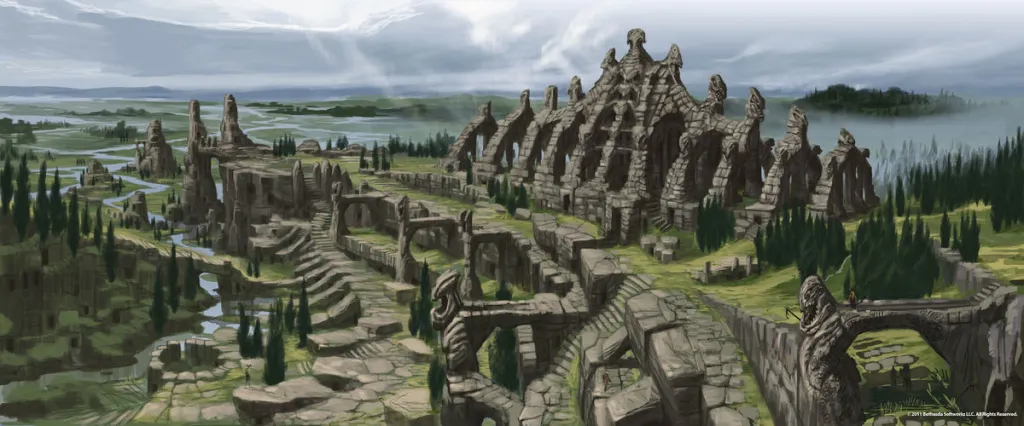

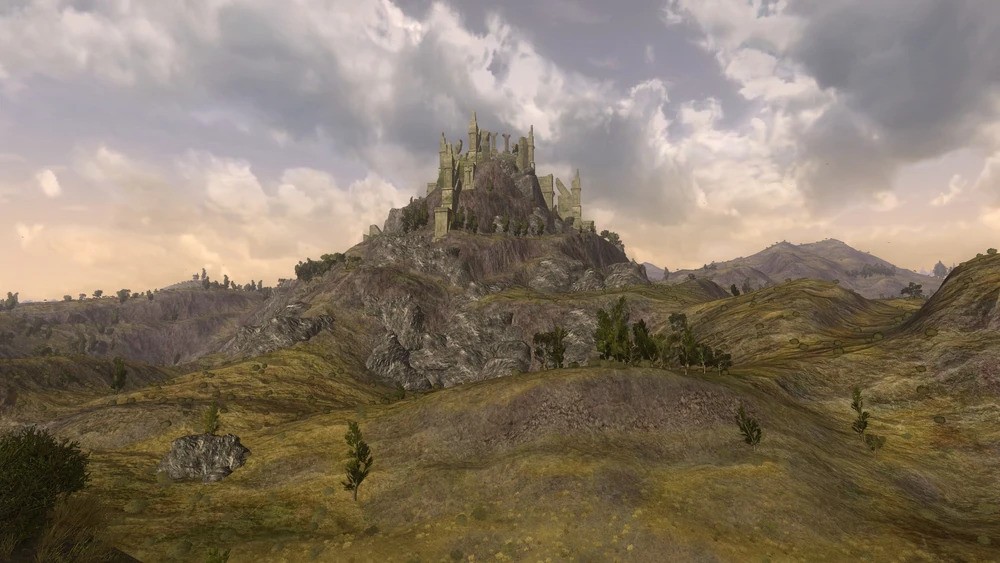
5 responses to “My light novel’s title can’t be this short! The evolution of light novel titles in another world!!!”
[…] with long titles than the opposite. Though it is not restricted to isekai light novels, since they, according to research, have the longest titles, with an average length of almost 40 characters, it is obvious that the […]
LikeLike
[…] com títulos longos do que o oposto. Embora não se restrinja a light novels isekai, já que elas, de acordo com a pesquisapossuem os títulos mais longos, com média de quase 40 caracteres, é óbvio que a “tendência de […]
LikeLike
[…] легкими романами исекай, поскольку они, согласно исследованиюимеют самые длинные заголовки, со средней длиной почти […]
LikeLike
[…] with long titles than the opposite. Though it is not restricted to isekai light novels, since they, according to research, have the longest titles, with an average length of almost 40 characters, it is obvious that the […]
LikeLike
[…] If you’re curious about exactly when long titles became the norm rather than the exception, check out this great article by Journal of Geek Studies. […]
LikeLike